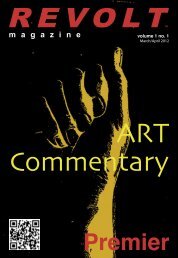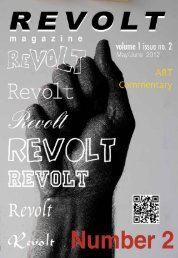Download PDF Version Revolt Magazine, Volume 1 Issue No.4
Download PDF Version Revolt Magazine, Volume 1 Issue No.4
Download PDF Version Revolt Magazine, Volume 1 Issue No.4
Create successful ePaper yourself
Turn your PDF publications into a flip-book with our unique Google optimized e-Paper software.
THE<br />
LITERARY<br />
VIEW<br />
Skyscraper Blues:<br />
Federico Garcia Lorca's Poet in New York<br />
BY DAN CALLAHAN<br />
Photos courtesy of Farrar, Straus and Giroux<br />
House of Bernarda Alba” and “Blood Wedding,” the<br />
Spanish writer Federico Garcia Lorca first came to<br />
prominence as a poet. His poetry collection “Gypsy<br />
Ballads,” published in 1928, was warmly received<br />
both in Spain and abroad, but Lorca bridled against<br />
being typecast. “The gypsies are a theme,” he<br />
wrote. “And nothing more. I could just as well be a<br />
poet of sewing needles or hydraulic landscapes.” In<br />
June of 1929, Lorca sailed for America, where he<br />
would stay in New York as a student at Columbia<br />
University. During his New York visit, he visited<br />
Harlem, saw the Stock Market crash, and wrote a<br />
book of poems, “Poet in New York,” which would<br />
the verse about Wall Street, where such negativity<br />
might be expected. His poem about a visit to<br />
Coney Island is called “Landscape of a Vomiting<br />
Multitude.” This is what he sees in a poem called<br />
“Dawn”:<br />
Dawn in New York has<br />
four columns of mire<br />
and a hurricane of black pigeons<br />
splashing in the putrid waters<br />
Dawn in New York groans<br />
On enormous fire escapes<br />
searching between the angles<br />
for spikenards of drafted anguish<br />
his rather strange and conflicted “Ode to Walt<br />
Whitman,” which is less of an ode to Whitman and<br />
more of an anguished plea for some kind of selfunderstanding.<br />
Many of the drawings by Lorca that preface some<br />
of these poems are delightful, but a lecture he<br />
gave on his New York stay, which is included here,<br />
feels almost comically at odds with the much<br />
more cheery version of his trip that he gives to his<br />
Lorca, who was homosexual, was very close to<br />
Salvador Dali, so intensely involved, in fact, that<br />
Dali finally had to distance himself from the older<br />
poet’s ardor. Luis Buñuel took a dim view of Lorca,<br />
and Lorca himself felt that Buñuel’s joint film with<br />
Dali, “Un Chien Andalou” (1928), was an attack on<br />
his person. “Buñuel has made a little shit of a film<br />
called ‘An Andalusian Dog,’ and the ‘Andalusian<br />
dog’ is me,” Lorca told his friend Ángel del Río. The<br />
influence of Dali’s surrealism on Lorca’s poetry in<br />
“Poet in New York” is clear, and the results can be<br />
felicitous. These poems are filled with unexpected<br />
combinations of descriptive words and images:<br />
only be published after his murder in 1936 at the<br />
hands of a Nationalist militia in Spain.<br />
“Poet in New York” was first put out in 1939 and<br />
1940 in Britain and the US. It has seen several<br />
translations since, and now this very handsome<br />
new bilingual edition from Farrar, Straus and<br />
Giroux that also includes some newly translated<br />
letters that Lorca wrote to his family. “Poet in New<br />
York” has not always had a positive press. It was<br />
thought anti-American by some when it was first<br />
published, and it remains a very thorny, almost<br />
wholly ambivalent work. Many of the poems do<br />
look at Manhattan in a negative way, and not just<br />
If it isn’t the birds<br />
covered with ash<br />
if it isn’t the sobbing that strikes the windows of<br />
the wedding<br />
it is the delicate creatures of the air<br />
that spill fresh blood in the inextinguishable<br />
darkness<br />
I love the combination of “inextinguishable” with<br />
“darkness,” and I love when Lorca references<br />
the “blue horse of my insanity.” So many of these<br />
images have a dreamlike rightness to them. That<br />
isn’t always the case when he tries to make a<br />
naïve but heartfelt plea for African Americans<br />
in “Standards and Paradise of the Blacks,” or<br />
mother in his letters home. Lorca was an artist who<br />
was always being violently torn between thoughts,<br />
emotions and positions, and this violence<br />
sometimes resulted in the hand-in-glove beauty<br />
of some of his poems and his great plays and<br />
sometimes led to some of the work in this book,<br />
which is a bit like hearing someone hit a piano hard<br />
to make a lot of discordant sound. “I badly want<br />
to communicate with you,” Lorca says in his New<br />
York lecture. “Not to give you honey (I have none)<br />
but sand or hemlock or salt water. Hand-to-hand<br />
fighting, and it does not matter if I am defeated.”<br />
REVOLT<br />
<strong>Magazine</strong> Number 4, 2013<br />
30





